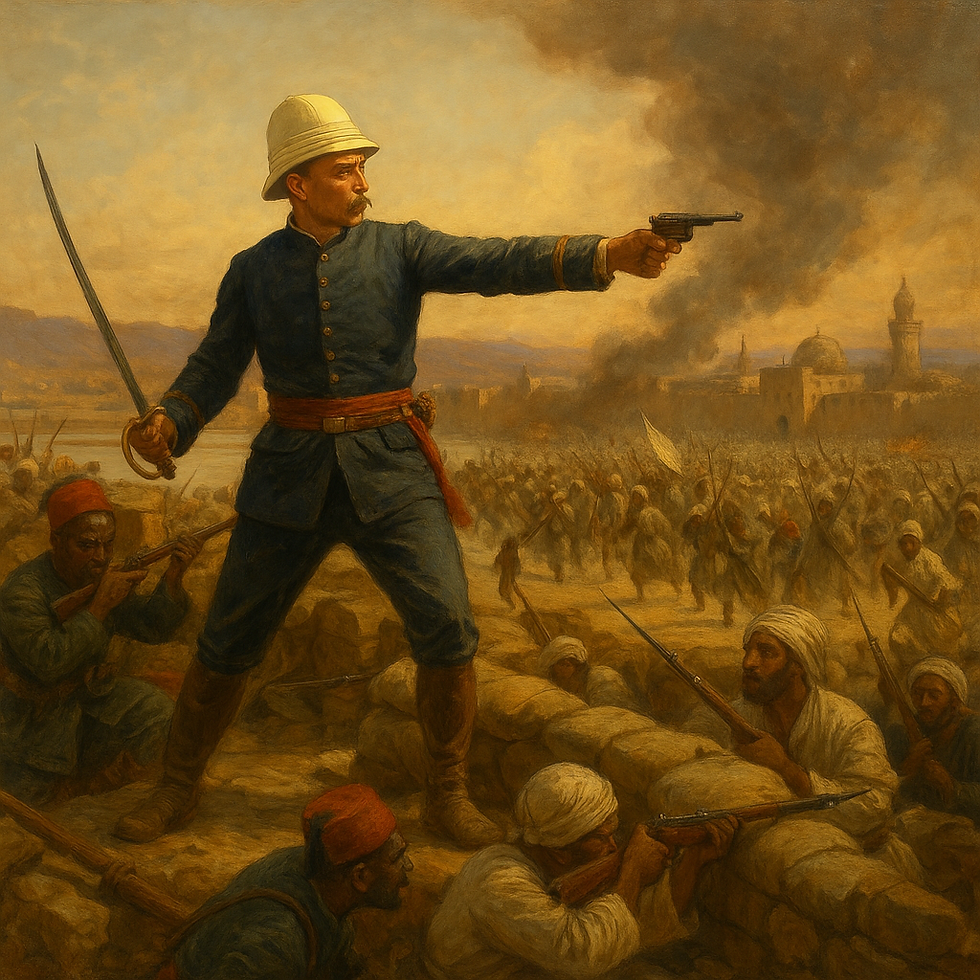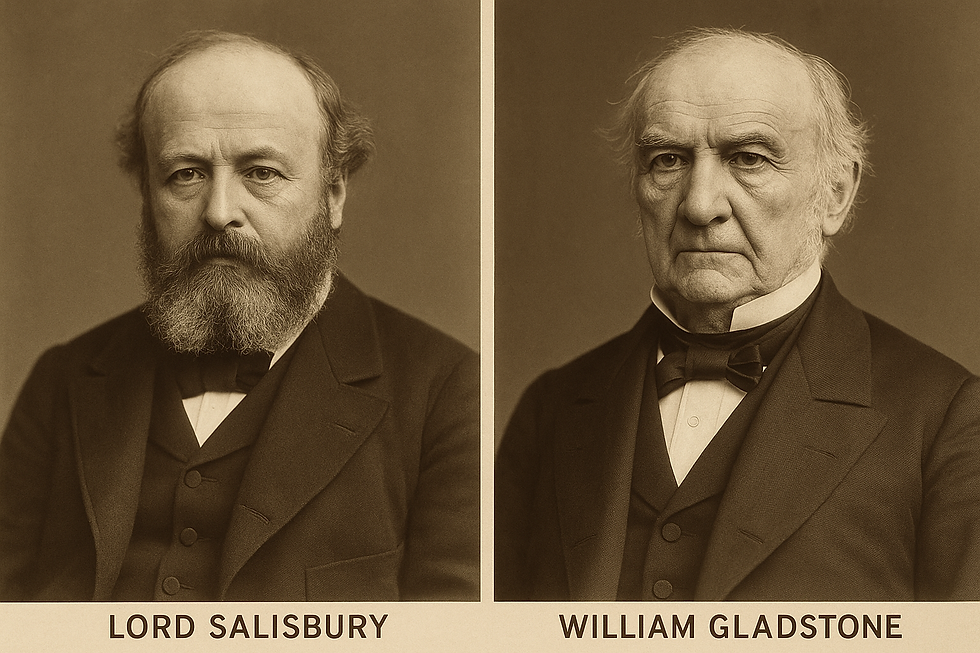The Defence of Khartoum: General Gordon’s Last Stand, 1884-1885
- Paul Jarvis
- Aug 9
- 7 min read

In the final decades of the nineteenth century, the British Empire found itself drawn into a remote and brutal struggle along the Nile. At the centre of this drama stood a single city, Khartoum in the heart of Sudan, whose defence became one of the most famous and controversial episodes in imperial military history. The siege that followed was marked by political hesitation in London, fierce determination on the ground, and the tragic death of a soldier whose name still resonates: General Charles George Gordon.
The Road to Khartoum
The origins of the siege lay in the Mahdist uprising in the Sudan. In the early 1880s, Muhammad Ahmad, a religious leader from Dongola Province, proclaimed himself the Mahdi, the “Guided One” foretold in Islamic tradition. His message combined religious revivalism with resistance to the corrupt Egyptian administration that ruled Sudan under nominal Ottoman suzerainty and British influence. Discontented tribes rallied to his cause, creating a formidable army inspired by religious fervour.

By 1883, the Mahdist movement had grown into a serious threat. The Egyptian government, under British pressure, attempted to suppress it with a large but poorly led expeditionary force commanded by British officer William Hicks. The result was disaster. At the Battle of El Obeid in November 1883, Hicks and nearly his entire army were annihilated. The route to the Nile was open, and the Egyptian position in Sudan began to collapse.
In London, Prime Minister William Gladstone’s government was reluctant to commit major resources to what was seen as an expensive and peripheral colonial venture. Instead, the decision was made to withdraw Egyptian forces and civilians from Sudan. To oversee this evacuation, the government called upon a man whose career combined military skill, administrative experience, and an aura of personal heroism: Major-General Charles Gordon.

Gordon Arrives
Gordon was already a celebrated figure. His service in China during the Taiping Rebellion had earned him the nickname “Chinese Gordon,” and his years as Governor-General of Sudan in the 1870s had left him familiar with the region and its peoples. In February 1884, he arrived in Khartoum to organise the withdrawal. What followed, however, was far from the simple evacuation London had envisaged.
Gordon found the situation in Khartoum precarious but not yet hopeless. The city, at the confluence of the Blue and White Niles, was a vital administrative and trading hub with strong defensive walls. He immediately began to strengthen these fortifications, gather supplies, and rally both Egyptian troops and local Sudanese to the cause. He also took a political step that alarmed London: instead of abandoning Khartoum, he proposed to hold it until a new administration could be established, one that might even involve the Mahdi in some negotiated settlement.
The Mahdi, however, had no interest in compromise. His forces advanced toward Khartoum, cutting off river access and surrounding the city. By March 1884, the siege had begun.

The Siege
Khartoum’s defences consisted of a network of earthworks and walls, reinforced under Gordon’s orders. The city’s garrison included several thousand Egyptian and Sudanese troops, supplemented by armed civilians. Gordon maintained strict rationing, organised sorties to disrupt Mahdist positions, and used the city’s few steam-powered gunboats to keep open what remained of the Nile supply route.
Morale within the city depended heavily on Gordon’s personal example. He was constantly visible, moving through the streets, encouraging soldiers, and working to maintain discipline. His leadership inspired loyalty among the defenders, yet his isolation from London grew. The British government maintained its policy of evacuation, and no relief expedition was immediately dispatched.
By the summer of 1884, the siege had entered a more desperate phase. The Mahdist army, now numbering tens of thousands, completed the tightening of its encirclement, occupying every approach to the city by land and controlling the river beyond Khartoum’s reach. The telegraph lines, Gordon’s last means of direct communication with Cairo and London, were cut, leaving only occasional messages sent by couriers in small steamers or by daring riders who risked capture in the desert.
With each passing week, the supply situation grew more precarious. The fertile islands in the Nile near the city, once a source of grain and vegetables, were stripped bare. The few stores of flour and preserved food were rationed with military precision, but hunger began to bite. The price of basic goods soared, and the poorer civilians were often left with little more than millet gruel or scraps of dried fish.
Disease followed hunger. The crowded quarters of Khartoum became breeding grounds for dysentery and smallpox, illnesses that spread quickly among soldiers and civilians alike. The Nile’s floodwaters, a blessing in peacetime, now carried silt and debris from upstream, clouding the drinking supply and adding to the toll on health.
Still, Gordon’s resolve did not falter. From his residence at the Governor-General’s palace, he continued to direct the city’s defences and to make his daily rounds, visiting the bastions, inspecting the gunboats, and speaking with the garrison commanders. His presence in the streets reassured many that the city would endure until help arrived. He remained convinced that a relief column must already be on its way and would reach Khartoum before the situation became irretrievable. In his mind, to abandon the city was to abandon its people to certain massacre, a course he could neither accept nor live with.
Political Debate in Britain
In Britain, public opinion became increasingly engaged with the events in Khartoum. Newspapers carried dramatic reports of Gordon’s predicament, often portraying him as a heroic figure abandoned by a hesitant government. The Conservative opposition, led by Lord Salisbury, pressed Prime Minister Gladstone to act. Eventually, the mounting political pressure forced a decision. In August 1884, the government authorised a relief expedition under General Garnet Wolseley to travel up the Nile and reach Khartoum.

The relief force, however, faced immense logistical challenges. The Nile’s cataracts slowed navigation, and the overland routes through the desert required extensive preparation. The Mahdist army, estimated at tens of thousands, presented a constant threat to any advance. Wolseley’s expedition progressed with determination but not speed, and the critical months of the siege passed with Gordon still holding out.
The Final Months
By late 1884, Khartoum was on the edge of collapse. Gordon’s steamers made daring runs along the Nile to harass Mahdist forces, but supplies were almost exhausted. The defenders were worn down by repeated attacks, artillery bombardment, and the strain of continuous readiness. Inside the city, famine set in, and deaths from starvation and disease mounted.
Gordon refused opportunities to escape, believing it dishonourable to abandon the garrison and the civilians who had remained loyal. His diary from these months shows a mixture of faith, fatalism, and defiance. He continued to send messages urging the relief force to hurry, while also preparing for the possibility that Khartoum might fall before help arrived.
The Fall of Khartoum
On the night of 25 January 1885, Mahdist forces launched a final assault. In the early hours of 26 January, they breached the defences, overwhelming the exhausted defenders. Fighting spread through the streets, and Gordon’s palace became the last point of resistance. According to most accounts, Gordon was killed in the fighting, possibly on the palace steps, his body later displayed by the Mahdists as proof of their victory.
Two days later, on 28 January, the advance elements of Wolseley’s relief expedition reached the Nile opposite Khartoum. They found the city in Mahdist hands, its defenders slaughtered, and the opportunity to save Gordon long lost.
Aftermath and Legacy
The fall of Khartoum was a political shock in Britain. Public outrage was intense, and the Gladstone government faced accusations of delay and neglect. The image of Gordon as a martyred hero became a powerful symbol, used by both his admirers and political opponents. Paintings and illustrations, notably George W. Joy’s “General Gordon’s Last Stand,” fixed the moment of his death in the Victorian imagination.

Strategically, the Mahdist victory secured their control over Sudan for more than a decade. It was not until 1898, at the Battle of Omdurman, that British and Egyptian forces under Kitchener reconquered the territory. The Mahdist state itself, however, endured internal struggles and external pressures until its eventual defeat.
From a military perspective, the Defence of Khartoum demonstrated both the potential and the limitations of imperial intervention in remote theatres. Gordon’s efforts to fortify and hold the city were skilful, and his leadership inspired a determined resistance. Yet the outcome was shaped as much by political hesitation and logistical obstacles as by battlefield events.
Assessment
The siege offers several lessons for the study of military history. First, it underscores the importance of aligning political objectives with military realities. The British government’s initial aim was evacuation, but Gordon’s decision to hold Khartoum transformed the mission into a defensive stand that required far greater resources than London had planned to commit.
Second, the events highlight the significance of logistics in colonial warfare. The slow progress of Wolseley’s relief expedition was not due to lack of effort but to the immense distances, harsh environment, and navigational challenges of the Nile. In such conditions, even a well-organised force could be too late.
Finally, the Defence of Khartoum illustrates the power of individual leadership in siege warfare. Gordon’s personal resolve, his daily presence among the troops, and his refusal to abandon the garrison became central to the city’s resistance. His death, whether viewed as a noble sacrifice or a tragic waste, ensured that the siege would be remembered far beyond its immediate strategic context.
Conclusion
The Defence of Khartoum remains one of the most compelling episodes of the Victorian era’s military history. It was a clash not only of armies but of political will, cultural perceptions, and personal conviction. For the Mahdists, it was a triumph that validated their cause and secured their rule. For Britain, it was both a humiliation and a rallying cry, shaping imperial policy in the Nile Valley for years to come.
General Gordon’s last stand continues to fascinate historians and the public alike. It is a story of courage under siege, of political miscalculation, and of the enduring human capacity to hold fast in the face of overwhelming odds. In the streets of Khartoum, in January 1885, the drama of empire played out to its bitter end, leaving a legacy that still echoes in the annals of military history.





Comments